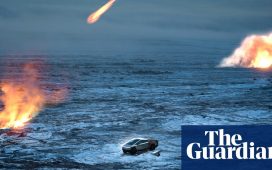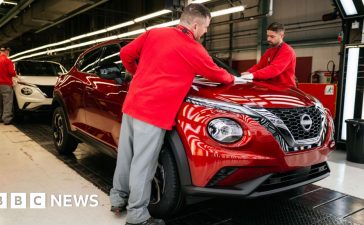From the energy generation perspective, mankind currently stands on the precipice of history. Mankind’s come to a point where it needs to make concrete decisions on how to supply roughly eight billion people with enough electricity to stretch each continent. On top of it all, a break-neck drive towards an all-electric automotive grid means that pretty soon, global demands for electricity are only going to increase exponentially.
But to understand why roads choked to the brim with electric cars might bode well for nuclear energy in the long run, we need to understand just how much power a fully-electric vehicle ecosystem would require to not fall apart. For starters, Americans consumed a gargantuan 142.8 billion gallons of gasoline in 2019, the last full year before the recent global health crisis started throwing off data. Assuming each gallon of gasoline is equal to 33.7 kWh, as stated by the U.S. EPA, this would mean the roughly 300 million cars and trucks currently on America’s roads needed around 4,800 billion kWh worth of energy to keep themselves fueled up over the course of that same year.
Though the EPA estimates it costs between 20 and 50 percent less to charge an EV than it does to fill an equivalent fuel tank, the tremendous battery capacities of high-end EVs combined with the proportionally higher amounts of time North Americans spend driving means the energy production needed to sustain a fully-electric automotive grid would still be astronomical. It’s difficult to predict just how much more energy would be required to power such an energy grid.
However, the U.S. Department of Energy believes it would require between 800 to 1,900 billion kWh of energy to sustain a fully electrified vehicle fleet over the course of a year, or between 20 and 50 percent more than the present day. That level of increase in power output can’t be solved with solar farms and wind turbines alone. In fact, the bulk of this energy would likely originate from fossil fuel-fired energy stations under current circumstances. There’s only one form of carbon-free energy production with the hope of bridging the gap, and that’s nuclear energy.
Whether from the traditional nuclear fission side of things or the recent cutting-edge advancements in nuclear fusion, there’s every reason to suspect that nuclear energy could be the path forward towards a nearly carbon-free energy future dominated by battery-electric EVs all in need of a charge-up. In the U.S. alone, there are currently 93 nuclear reactors in operation across 23 states.
It must be said these nearly 100-strong nuclear reactors account for just under 20 percent of the US’s total energy production. But could better, safer, more powerful reactors change that in the near future? Some argue it already has. You see all nuclear reactors built before the mid-1990s represent the second generation of commercial fission reactors. Be it the General Electric boiling-water reactors in Fukushima Daiichi or the RBMK that went haywire at Chornobyl, they both belong to this broad category of nuclear facilities built between the late 1960s and the early 90s.
The first third-generation nuclear reactors to reach full-scale commercial service were two GE Hitachi advanced boiling water reactors (ABWRs) at the Kashiwazaki-Kariwa Nuclear Power Plant in Niigata Prefecture, Japan, in 1996 and 1997. Across the globe, top names in energy production like General Electric and Westinghouse in the U.S., Candu Energy Inc. in Canada, Mitsubishi, and Toshiba in Japan, and various Russian and Chinese-state-controlled energy conglomerates have built a dozen more gen-III reactors according to the World Nuclear Association.
With the ability to generate large quantities of nuclear fission through a relatively small amount of fissile fuel, expanding global power grids with gen-III reactors could facilitate the global switch towards electric car charging without sacrificing energy in other areas. Their potential scalability down to tiny reactors that easily fit inside an average warehouse, as with Westinghouse’s eVinci, brings potential fleets of small reactors running in parallel into the realm of viability. In cities like London, New York, or Los Angeles, where millions of EVs will soon be charging up all at once, such nuclear reactors proliferating in the near future would be a welcome sign, especially as the cost of gasoline inevitably spirals out of control soon enough.
But while various European countries like France and the UK and US states like Illinois and Pennsylvania have fully taken nuclear energy to heart, their neighbors are often totally different stories. Across the border in Germany and Italy, two states have largely abandoned their civil nuclear energy programs. Germany’s final operational fission reactor shut down in April 2023, and 12 US states have active moratoriums on building new reactor sites, including California, Connecticut, and New York. In a great number of cases, rising public sentiment against potential nuclear reactor sites in their own neighborhoods is at the spearhead of this legislation.
But it’s the very same fears for safety on the part of the public that modern fission reactors aim to vanquish with their innovative designs. Rapid advancements in fissile fuel, where only a fraction of the quantity of fuel is needed compared to older reactors, reduce the risk of large, uncontrollable meltdowns lobbing tons of radioactive material into the atmosphere during an emergency. Further workarounds to common problems, such as the positive void coefficient of Chornobyl’s RBMK reactors, have been implemented in recent years. Meltdowns caused by natural disasters like Fukushima notwithstanding, there hasn’t been a major nuclear accident attributed solely to human error since 1986.
With the oil and natural gas-producing nations of the world throwing their weight around like never before, governments that once turned their backs on nuclear energy might find themselves scrambling to change course as ever-increasing magnitudes of EVs strain local power grids to the absolute brink. But even beyond simply focusing on electric vehicles, even more pressing concerns like heating and air conditioning during increasingly extreme winters and summers in the Northern Hemisphere will soon demand energy in a way only nuclear fission can realistically supply without emitting any carbon.
In a modern world where a deeply conservative petrochemical energy sector shares real estate with a repertoire of renewable energy production methods that can only meet demand when used in unison, it’s fair to say factoring nuclear energy into the same picture as wind turbines and hydro-electric energy bodes well towards presenting a concrete path away from a global reliance on finite fossil fuels. It may sound like a trivial change in semantics to some people, but these distinctions matter when the future of the human race depends on presenting workable solutions to kicking nat-gas, coal, and oil to the curb long term.
In the end, the more pressing matter is whether the people who once rejected nuclear energy in all its forms relent in their criticisms or carry on cutting deals with less-than-reputable petrostates to keep their homes and businesses every winter. For purely humanitarian reasons that have nothing to do with energy, we have reason to suspect that Italy, Germany, and many others around the world might one day soon change their attitude towards nuclear energy.















